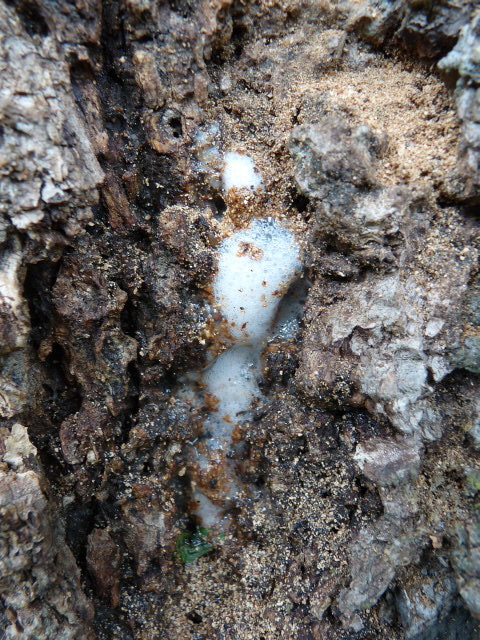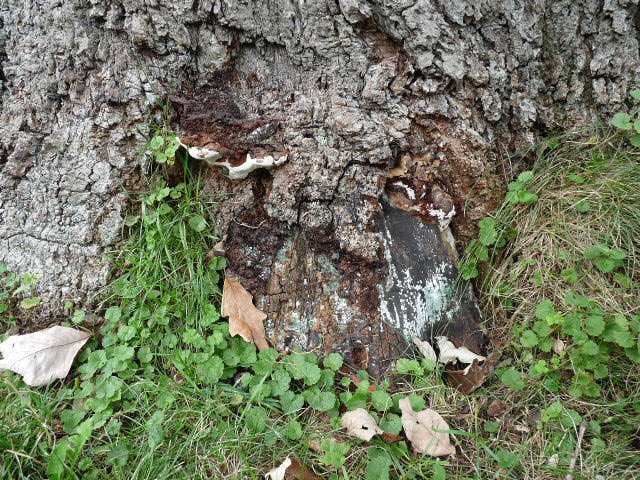Question
 wetwood
wetwood  collar rot
collar rot
We have a giant, pre civil war bur oak in the center of our backyard. It was diagnosed with collar rot last fall and we had it treated with an anti fungal recently. Now we are noticing that it seems to have bacterial wetwood. There is the white foam coming out from the base in one small location and all sorts of insects are loving it, flies, ants, butterflies and wasps. In addition to the white foam, there seems to be sawdust coming from around the area (possible the ants nesting in the wood?). It is a beautiful tree, but would take out a house in any direction it fell towards. We also have another old oak in the back corner of our back yard that seems healthy. Is the sick oak likely to infect the healthy tree? Also how long is the sick oak likely to live with these kinds of problems?
AnswerI think you have a couple of problems. The first looks like an insect called a borer. These insect bore into the bark and wood and produce the wood shavings you are seeing. This also allows the slime flux to enter the trees system.
Borers attack trees under stress. You can spray an insecticide on the bark of the oaks where the borers have entered and this will kill the insects under the bark. Use an insecticide called Onyx or Merit. Check with your local garden type store for these.
Stress can be caused by many things--dry weather or lack of nutrients in the soil are a couple of them. I would expect that your area has experienced drought like conditions this past year or so. Not much you can do in this situation but try to reduce the borer population with the insecticide spray. I would suggest fertilizing the trees with 10-10-10 fertilizer at the rate of 1 lb of fertilizer per inch of trunk diameter scattered around the tree and watered in good, Apply just before a rain storm and you will not have to water.
The oozing is called "slime flux" and is caused by a bacterial infection inside the trunk. There are actually two types of slime flux: 揳lcoholic?and 揳cidic? The acidic flux smells like vinegar.
The infection can be in a wound on the trunk surface or it can be deeper inside the trunk. In either case, bacteria ferment the tree's sap; it seeps out and down to the ground. Sweet-eating insects #wasps, bees, yellow jackets# would obviously be attracted to the damaged area.
There is no treatment for the condition. The best thing to do is to wash off the trunk to discourage bugs. Mix a pint of chlorine bleach in a gallon of water to make a final rinse. The flow of sap is periodic; it may disappear and not reoccur or you may see it every year.
Slime flux is a bacterial disease. The infected wood is frequently discolored or appears water soaked #wet wood#. Gas #carbon dioxide# is produced by fermentation by bacteria. The gas produces pressure in the wood. This pressure forces sap from the trunk through cracks in branch crotch unions, pruning wounds, lawn mower wounds, other injuries and occasionally unwounded bark. This oozing of sap is termed fluxing. The flux is colorless to tan at first but darkens up exposure to the air. As fluxing continues, large areas of the bark become soaked. Many different microorganisms grow in the flux producing a foul or alcoholic smell. Various types of insects are attracted to the slime flux. If the fluxing continues for months, leaves on affected branches may be stunted and chlorotic. Grass may be killed where the flux runs down the trunk onto the grass.
Large mature landscape oaks have had problems with slime flux on the trunk or large exposed flare roots just above the soil line with no apparent wounds or injuries. Sap may continue to ooze for several weeks or months, but usually it eventually stops with no treatment and no apparent damage to the tree. This slime flux may be triggered by heat, drought and other stress.
There is no curative or preventive measures for slime flux except to maintain trees in a general good state of vigor and minimize wounds and injuries. Again, I would fertilize the tree with 10-10-10 fertilizer at the rate of 1 lb per inch of diameter scattered around the tree and watered in good. This will help improve the overall health of the tree.
No the sick tree is not likely to infect the other trees but I would also fertilize them to increase the health. I would fertilize now and again in the spring.If kept healthy these trees should last a lot longer.







